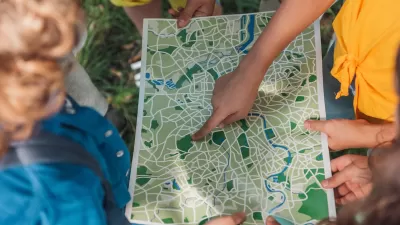Tim Maly analyses a stunning high-resolution map of America’s forests for its lessons on the subtle choices that go into good visual information design for multiple audiences.
NASA's map, built from 265 million segments and accurate to within 30 meters, is intended to be a tool for understanding exactly how much carbon our trees can absorb. Based on data gathered by the Woods Hole Research Center's (WHRC) National Biomass and Carbon Dataset (NBCD), the map has been developed to a scale "which means that forest managers and researchers can track the disruption caused by things as small as a parking lot or a large building," writes Maly.
In developing the map however, Robert Simmon, art director of NASA's Earth Observatory, who published the map, wanted it to be accessible for non-experts as well. That meant paying close attention to how certain colors are interpreted and how patterns and relationships are conveyed.
According to Maly, "Good information design for the public is about clarity and impact. Simmon says that his primary goal as an information designer is to create 'almost an emotional reaction with people.' He wants to make that first 'getting what it is' as easy as possible while retaining as much information as possible in the display so the more you look at it, the more you see. 'It's a classical design sense of creating a hierarchy of information.'"
FULL STORY: NASA Creates Insanely High-Res Map Of America’s Trees, And Offers A Lesson In Information Design

Manufactured Crisis: Losing the Nation’s Largest Source of Unsubsidized Affordable Housing
Manufactured housing communities have long been an affordable housing option for millions of people living in the U.S., but that affordability is disappearing rapidly. How did we get here?

Americans May Be Stuck — But Why?
Americans are moving a lot less than they once did, and that is a problem. While Yoni Applebaum, in his highly-publicized article Stuck, gets the reasons badly wrong, it's still important to ask: why are we moving so much less than before?

Using Old Oil and Gas Wells for Green Energy Storage
Penn State researchers have found that repurposing abandoned oil and gas wells for geothermal-assisted compressed-air energy storage can boost efficiency, reduce environmental risks, and support clean energy and job transitions.

Updating LA’s Tree Rules Could Bring More Shade to Underserved Neighborhoods
A new USC study finds that relaxing Los Angeles’ outdated tree planting guidelines could significantly expand urban tree canopy and reduce shade disparities in lower-income neighborhoods, though infrastructure investments are also needed.

California's Canal Solar Projects Aim to Conserve Resources and Expand Clean Energy
California’s Project Nexus has begun generating electricity from solar panels installed over irrigation canals, with researchers and state agencies exploring statewide expansion to conserve water and boost clean energy production.

HHS Staff Cuts Gut Energy Assistance Program
The full staff of a federal program that distributes heating and cooling assistance for low-income families was laid off, jeopardizing the program’s operations.
Urban Design for Planners 1: Software Tools
This six-course series explores essential urban design concepts using open source software and equips planners with the tools they need to participate fully in the urban design process.
Planning for Universal Design
Learn the tools for implementing Universal Design in planning regulations.
Heyer Gruel & Associates PA
City of Moreno Valley
Institute for Housing and Urban Development Studies (IHS)
City of Grandview
Harvard GSD Executive Education
Salt Lake City
NYU Wagner Graduate School of Public Service
City of Cambridge, Maryland





























